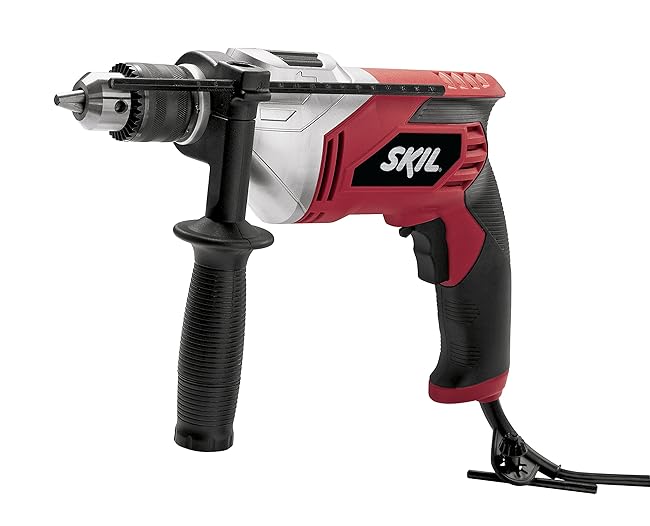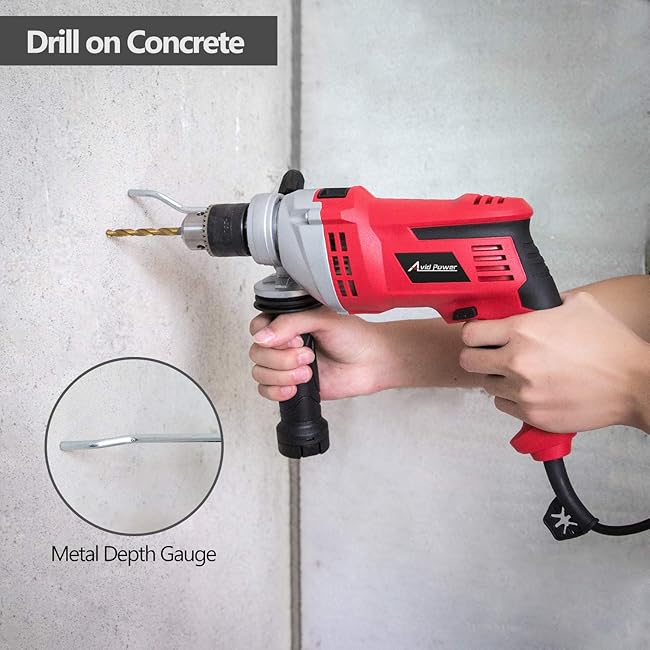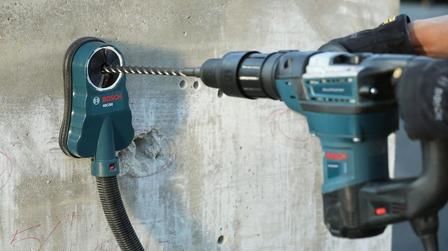The difference between a seasoned technician and a beginner is that the former knows what special tools will get his job done quickly and how to use them. He knows how to use a hammer drill, when to use it, and why. And the easiest way to bridge that difference is to start from the basics.

Here’s a beginner’s guide on how to use a rotary hammer drill.
Before you purchase one, it is important to understand its core functions, factors involved, features, and drawbacks. This short guide will cover everything that you will need to get on the field and operate one.
Let’s start with the tool basics. But if you are in a hurry, jump to the next section directly.
Hammer Drill Basics
Before we jump into how we need to learn and understand the what, the why, and the when.
So that you know what a hammer drill does, why it is preferred over regular drills, and when to use it. First off – definition!
What is Hammer Drill?
A hammer drill is an advanced power drill equipped with a hammering mechanism for stronger drill performance and boring ability.
It combines the actions of a general-purpose hand drill and a hammer to bring out potent energy that can drill through concrete, stone, mortar, brick, metals, and other hard materials. It uses masonry bits (and other similar types) to complete the action.
It is not suitable for driving or unfastening screws unless it has an added mechanism for that too. You pick impact drivers for that job.

Why Use a Hammer Drill?
The point of a hammer drill – sometimes also known as an impact drill or percussion drill – is to help you bore harder materials that are otherwise not possible using a regular tool like the DeWALT DWD112.
Preferred by construction engineers and DIYers to drill though stone walls, reinforced concrete, and sometimes even wood, it is a handy addition to your mechanical toolkit.
When to Use It?
Most professionals prefer to have different drills for different purposes. But that’s not economical if you are a beginner DIYer.
So, invest in a hammer drill if you are always on the field in construction sites and frequently need to use more power to drill through hard materials.
Moreover, using a conventional DeWALT drill on concrete or stone can severely affect its health.
For a beginner, compare your requirements against the following list of applications:
- Drill holes in concrete footings, floors, walls, and stone tiles
- Mini jackhammering
- Split large boulders, stones, slabs
- Equip mortar joints

Types of Hammer Drills
There are three common types:
- Rotary hammers aka dedicated hammer drills
- Cordless hammer drills
- Corded hammer drills
While most hammer drills come with a switch that can convert them to regular drills (and even into drivers), it is recommended that you measure your requirements against their core features before buying.
Even today, engineers and technicians prefer to have separate tools for separate tasks.
How to Use a Hammer Drill
Drilling through concrete using a standard hand drill can be daunting. And even more so for beginners.
This nifty guide here on how to use a hammer drill takes a basics approach that is safe for everyone and everything involved.
Here’s a step-by-step guide to using a hammer drill the right way, the professional way:
Step 1 – Choose a Hammer Drill
Choose a hammer drill that suits your specific needs. Check out our buying guide for more information, top choices, and expert reviews. While most experts suggest renting one, you should compare the cost required to do so (usually $40 a day and upwards) against the cost of owning one permanently.

If yours is a cordless model, make sure it has enough juice for the particular project before you start working. Or carry spares. If it’s a corded one, find a power supply socket closer to the work area to avoid tugging.
Step 2 – Choose Appropriate Drill Bit and Fit It
Select an appropriate drill bit. This is the most important step because unlike regular drills, rotary hammers require bits that can both withstand the high torque and quick, repetitive motions and pass it on to the surface of the material being bored.
You are looking at high-tensile masonry drill bits made of carbide and preferably with Special Direct System (SDS).
Most manufacturers like DeWALT and Makita have lists of recommended drill bit types for each of their models or series. This is why you should take a good look at the instruction manual as well. The manufacturer website is also often a gold mine of information for newbies.

Use a chuck to tighten the bit into the drill. Remember loose drill bits are one of the biggest causes of power tool mishaps.
Step 3 – Measure and Set the Depth
Set the depth of your drill as a cue for self or for the tool to stop drilling after achieving a certain length of the cavity inside the material.
Most modern hammer drills have an in-built depth stop function, but if yours doesn’t a tape will come handy.
Once you have set the depth, move on to the main part.
Step 4 – Hold the Hammer Drill and Get Ready
Stand with your feet shoulders apart and hold the drill with both hands. Hold it like a pistol with your better hand; your index finger on the trigger/switch. Use the other hand on top to maintain the level and to avoid the drill from running.

Most hammer drills these days have an ergonomic side handle for better grip and handling.
For example, the SKIL 6445-04 is an inexpensive drill that comes with a side-assistance handle. It is one of our top hammer drill choices in the market today.
Step 5 – Switch On, Point, and Start Drilling
Switch ON the drill. Point the drill exactly perpendicular (90 degrees) against the surface and start drilling slowly.
Once the bit gets locked into the point, gradually increase speed. Continue drilling at a moderate speed to achieve the required depth.

NOTE: The drilling sound of a rotary hammer is at least 5x more than a regular drill. Therefore, earmuffs are recommended.
If you have the paper tape with you, paste it as a cross sign (x) on the surface and make a mark at the center. This will prevent the running of the drill bit.
Step 6 – Re-drilling for Smoother Finish, Debris Removal
If you need a slightly wider gape for plastic anchors or to feed wires, rerun the drill in the hole at slow speed to remove debris. You may then use a blower to clean up the hole for free movement of anchors, wires, and bolts
That’s it. You have successfully learned how to use a hammer drill.
Here are a few more pointers that will help you in case you own a model with certain special features.
Additional Steps for Beginners
- Turn ON the LED light before starting the drilling and keep it ON throughout the drilling phase. Of course, this is needed only for dark or dimly-lit areas
- Use the top speed setting sparingly; it is recommended that the highest speed be used only for surfaces that are harder to bore
- Some hammer drills have special triggers where you can do a slow press while starting up and then press down more to increase the speed. This is a really great feature for beginners but it requires a skill.
Now that you have learned how to use a hammer drill, it is time to go one step further.
Tips to Use a Hammer Drills
How to Hold It Like a Pro?
The art of hammer drilling solely depends on how you hold it.
How you hold the drill in your hands will decide the success or failure of the task at hand.
Learn it here with this fantastic tip –
- Maintain a 90-degree angle with the surface, holding the hammer drill with both hands, and – this is important – push through your arms and not the body
- Most beginners do the mistake of putting the entire upper body weight on the drill bit as if it is an assault on the hard surface. It is not (as it can also cause the bit to break). So, use the muscles of your arms to gently push the drill against the surface without moving your body
- Try it out on test jobs a few times to master the art.

Essential Safety Tips
Some useful tips to keep in mind while operating a hammer drill:
- ALWAYS use both hands
- Invest in
- Goggles (safety glasses) – to prevent pieces of wood or shrapnel from metal materials slipping off the surface and hitting you on the face. Full face masks can also be considered
- Ear mufflers – hammer drills make a deafening noise. Buy a pair of earmuffs and always put them on while operating. If there’s anyone else in the area while you are doing it, they should also be wearing one ideally
- Hand gloves – this is a no-brainer!
- Masks for mouth and nose are also recommended if you are in a construction site
- Buy a hard hat and keep it in your toolkit for use while working in dangerous conditions
- Use only carbide masonry bits
- Always use a hammer drill on concrete, stone, rock
- A standard drill can often handle wood and brick
- If it’s your first time, ask for a helping hand.
General Tips and Tricks
- Do not push the drill against the surface with your body
- Torque (rotational force) influences the speed (measured in RPM or BPM) whereas power influences the hammering motion. Use this understanding for better drill judgments
- If you are drilling on a concrete wall in a room currently being used, place a sheet or a cloth below the surface to collect debris
- Keep the drill bit cleaned and occasionally oiled

- Splash water on the material surface before drilling to allow for less friction and heat
- Some engineers also run continuous water through the drilling part for this purpose. It can be very effective
- The quality of a good hammer drill can be judged by the time it takes to drill a two-inch deep hole on a concrete block. The ideal time is less than one minute.
Final Thoughts
Learning how to use a hammer drill is not difficult if you know the basics and its operation. It’s like driving: once you know the basics and have driven a four-wheeler sedan before, you can easily drive an SUV, a bus, and even a truck with a little practice and a hands-on approach.
While you run through these steps, it is recommended that you keep the instruction manual of your own model handy. It will save you a lot of time understanding the functions as well as give you an added trust, coming directly from the manufacturer.
So, get out and reap the benefits of the wonderful power tool technology of a hammer drill.
Let us know about your experiences in the comments below.


